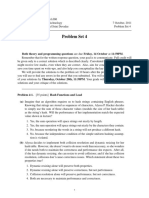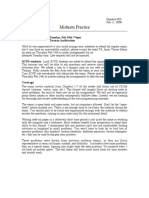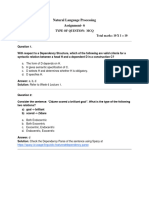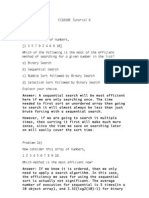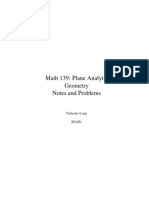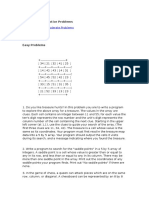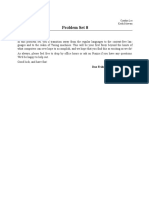Diagonsis Test
Diagonsis Test
Uploaded by
sreepranad DevarakondaCopyright:
Available Formats
Diagonsis Test
Diagonsis Test
Uploaded by
sreepranad DevarakondaCopyright
Available Formats
Share this document
Did you find this document useful?
Is this content inappropriate?
Copyright:
Available Formats
Diagonsis Test
Diagonsis Test
Uploaded by
sreepranad DevarakondaCopyright:
Available Formats
Are You Ready?
CodeWOOT
Overview
This diagnostic test is a set of multiple-choice questions (rather than complete USACO-style coding
problems) so that we can cover more topics in less time. Some questions may involve ideas or terms
that you have not seen before – it’s OK not to get everything right, and some problems might be good
learning experiences for you! Just do the best you can with the knowledge you currently have. There is no
time limit.
A Note On Big-O Notation
In case you are unfamiliar with big-O notation, you can think of it informally as describing how the
running time of a solution scales with the size of the dataset that it runs on. If a piece of code runs on a
list with N elements and has a running time of O(N 2 ), for example, then doubling the length of the list
will make the code take roughly four times as long to run. Notice that this notation obscures constant
factors and lower-order terms; 3N 2 and N 2 + 7N are both O(N 2 ), but the second one might be
noticeably faster in practice.
Big-O notation is not used directly in the USACO, but it is important to be able to understand roughly how
fast we can expect a solution to run. As a good rule of thumb, expect that your code will be able to
perform around 108 operations in 2 seconds on the USACO servers. For example, when N can be as large
as 105 , an O(N 2 ) solution would be too slow for the USACO time limit, so there is not much point in
implementing one except maybe to pick off a few easier test cases. However, an O(N log N ) solution
would probably be �ne.
Scoring Guide
Each question is worth � point.
• �6–�� questions correct: You have an excellent foundation for CodeWOOT. We hope to see you in
class!
• ��–�� questions correct: You can succeed in CodeWOOT if you are motivated and willing to put in
some extra work – particularly if you are already a mid or high Silver solver, and/or some of the
misses are due to small mistakes or a lack of familiarity with some terms. Be sure to read the
explanations for the questions you got wrong.
• �–�� questions correct: The course may be too challenging for you at the moment. We
recommend practicing more with USACO problems and learning more about Bronze and Silver level
algorithms and data structures.
Good luck!
Questions begin on the next page.
© ���� AoPS Incorporated �
Are You Ready? CodeWOOT
�. For Questions �-�, consider the following problem.
Farmer John has �6 bales of hay, each of which is labeled with a different uppercase letter
of the English alphabet. He has arranged the bales in a ring so that they read ABC ... Z in
clockwise order.
Farmer John will give Bessie a word W (no more than N letters long, 1 N 105 )
and ask her to spell it out by walking clockwise around the circle. When Bessie reaches a
bale of hay, she can choose to say that bale’s letter as many times as she wants (possibly
zero) before moo-ving on. Bessie is done when she has said every letter in W , in the order
in which those letters appear in W .
Bessie starts just before bale A (right between Z and A, heading toward A). Her goal is
to minimize the total number of complete cycles she makes around the ring of bales, i.e.,
the number of times she reaches this original starting point again. What is this minimum
number?
(For example, the answer for the test case BESSIE is �, and the answer for the test
case FORTY is �.)
Suppose we write code that moves Bessie one bale at a time, and has her make as much remaining
progress through the word as possible at each bale (i.e., saying a letter multiple times if needed)
before moving to the next bale. Which of the following, if any, is NOT true about this approach?
(a) This approach will always return the correct answer.
(b) This approach is likely to be fast enough for the typical � second USACO time limit.
(c) The approach takes O(N ) time (time linear in the length of W ).
(d) The approach is asymptotically optimal, i.e., any solution to this problem takes O(N ) time or
worse.
(e) All of the above are true.
�. There is a cleverer (and easier to code) approach that can get the answer based only on. . .
(a) ...the total number of instances of the letter A in W .
(b) ...the maximum number of instances of any one letter in W .
(c) ...the longest consecutive sequence of letters in W that are in alphabetical order.
(d) ...the number of pairs of consecutive letters in W that are not in alphabetical order.
(e) ...the number of pairs of letters (anywhere in W ) that are not in alphabetical order.
© ���� AoPS Incorporated �
Are You Ready? CodeWOOT
�. One advantage of using a doubly linked list over an array (e.g., vector<int> or int[] in C++,
ArrayList<Integer> or int[] in Java, list in Python) is that
(a) Binary searching a linked list is generally much faster than binary searching an array.
(b) Assuming we have a way to directly access the place in a linked list where we want to insert a
new element, inserting into the middle of a linked list is generally much faster than inserting
into the middle of an array.
(c) Assuming we have a way to directly access the place in a linked list where we want to insert a
new element, inserting an element at the end of a linked list is generally much faster than
inserting an element at the end of an array.
(d) Linked list operations are generally faster than array operations because linked lists take less
total storage space in memory.
(e) Linked lists can be stored in a single contiguous block of memory, whereas arrays cannot.
�. In a typical associative array (e.g. map in C++, HashMap in Java, dictionaries in Python), which of the
following operations is NOT supported in constant (or nearly constant) time?
(a) Insert a new key-value pair into the associative array.
(b) Check whether a particular key is in the associative array.
(c) Check whether a particular value is in the associative array.
(d) Retrieve the value for a particular key.
(e) Delete a particular key-value pair from the associative array.
�. It is generally best to avoid using �oating point numbers (e.g., double in C++ or Java, or the result
of using / rather than // to divide in Python) in coding contest problems where the desired answer
is an integer, even when decimals may be involved in the computation. The most important reason
for this is that
(a) Operations on �oating point numbers tend to be slower overall.
(b) All �oating point representations of non-integer numbers are inexact.
(c) Suf�ciently large integers cannot be represented exactly as �oating point numbers.
(d) Suf�ciently small integers cannot be represented exactly as �oating point numbers.
(e) It is possible that some intermediate values in the computation cannot be represented exactly
as �oating point numbers, in which case errors can accumulate.
© ���� AoPS Incorporated �
Are You Ready? CodeWOOT
6. For Questions 6-�, consider the following problem.
Some – but not all – of Farmer John’s N cows (2 N 105 ) are friends with each other. In
this problem, friendship is two-way: if a cow A is friends with some other cow B, then cow
B is necessarily also friends with cow A.
Two cows are ”networked” if there is a path of connections between them formed by
friendships. That is, either they are directly friends with each other, or they have a mutual
friend, or the �rst cow is friends with a cow who is friends with a cow who is friends with
the second cow, etc.
Farmer John is going to choose two cows who are not already friends and make them
friends. Moreover, he will do this in a way that causes the total number of pairs of networked
cows to increase as much as possible. These pairs are unordered – i.e., ”Bessie and Elsie”
does not count as a different pair than ”Elsie and Bessie”. (Notice that the number will
always increase by at least �, since it includes the pair of cows that Farmer John chose to
make friends.)
For example, suppose there are three cows A, B, C, and (only) A and B are already
friends. Then if Farmer John makes cows A and C friends, the total number of pairs of
networked cows increases from one to three: a total increase of two.
Consider all possible data sets with exactly 10 cows. What is the largest possible increase (in the
total number of pairs of networked cows) that Farmer John could achieve?
(a) 9
(b) 18
(c) 25
(d) 36
(e) 45
�. Which of the following high-level approaches would be most appropriate for solving Farmer John’s
problem ef�ciently?
(a) Complete search
(b) Binary search
(c) Finding connected components
(d) Sorting
(e) Divide and conquer
© ���� AoPS Incorporated �
Are You Ready? CodeWOOT
8. Which of the following graph traversal techniques would be suitable as a piece of that solution?
(a) Breadth-�rst search
(b) Depth-�rst search
(c) Cycle detection
(d) Either (a) or (b)
(e) Any of (a), (b), or (c)
�. Consider the following algorithm:
• For each cow i, �nd how many friends Fi they have.
• Sort all the cows (e.g., using MergeSort) in decreasing order of Fi .
• Find two cows i and j who are not already networked and who have the largest possible Fi +
Fj , and make them friends. (If there are multiple such pairs, choose the one with the smallest
i, and then if there is still a tie, choose the one with the smallest j.)
Which of the following statements about this approach is/are true?
(a) The approach can be implemented in a way that takes O(N ) time even in the worst case.
(b) The approach always returns the correct answer.
(c) Both (a) and (b) are true.
(d) Neither (a) nor (b) is true.
(e) Farmer John is a completely normal person with completely normal hobbies.
© ���� AoPS Incorporated �
Are You Ready? CodeWOOT
��. Here are some statements about connected, undirected graphs with N vertices; assume that
N > 2. Which of the following statements is NOT true?
(a) A connected, undirected graph that has exactly N vertices and exactly N 1 edges has at
least two leaves (i.e., vertices with only a single edge).
(b) A connected, undirected graph that has exactly N vertices and exactly N 1 edges has
exactly one path between any two vertices.
(c) In a connected, undirected graph that has exactly N vertices and N 1 edges, a vertex might
have as few as one edge, or as many as N 1 edges.
(d) A connected, undirected graph that has exactly N vertices and exactly N edges necessarily
has a cycle.
(e) Removing an edge from a connected, undirected graph that has exactly N vertices and exactly
N edges necessarily leaves behind a tree.
��. Suppose that a solution to a problem explicitly checks every possible ordering of N things, and
checking each ordering takes linear (O(N )) time. Which of these would you expect to be (roughly)
the largest value of N for which this approach would be fast enough for the standard USACO �
second time limit?
(a) 4
(b) 8
(c) 16
(d) 32
(e) 64
��. Bessie is in a grid with R rows and C columns; the top left cell is numbered (1, 1), and the bottom
right cell is numbered (R, C). Bessie starts in the cell numbered (r, c), and she wants to reach the
bottom right cell by only making moves down and/or to the right, without exiting the grid.
Let P (x, y) denote the number of possible paths Bessie can take from the starting cell to (R, C).
We say P (R, C) = 1 even though this ”path” is trivial.
Which of the following is NOT true?
(a) P (x, C) = 1 for all 1 x R.
(b) P (R, y) = 1 for all 1 y C.
(c) P (x, y) = P (x + 1, y) + P (x, y + 1), for all x < R and y < C.
(d) For any integer value v between 1 and max(R, C), there is a cell (x, y) for which P (x, y) = v.
(e) P (1, 1) = R ⇥ C.
© ���� AoPS Incorporated 6
Are You Ready? CodeWOOT
��. Bessie has a directed graph of 10 vertices, in which each vertex has exactly one outgoing edge.
What is the minimum number of vertices in such a graph that must be part of a cycle – i.e., they can
be reached again after leaving them?
(a) 0
(b) 2
(c) 5
(d) 8
(e) 10
��. Given a list of N integers (some or all of which might be negative), which of the following problems
cannot be solved with only a single linear pass through the list and only a constant amount of
memory? (Speci�cally, an amount not proportional to N ).
(a) Find the largest sum of any two different elements anywhere in the list.
(b) Find the smallest sum of any two different elements anywhere in the list.
(c) Find the largest difference between any two different elements anywhere in the list.
(d) Find the smallest difference between any two different elements anywhere in the list.
(e) Find the smallest product of any two different elements anywhere in the list.
��. Which of the following situations, if any, would NOT be suitable for binary search?
(a) Find the largest natural number N for which N 1.01 + 1.01N 250.
(b) Find the largest natural number N that is prime, is made up of nonzero digits, and has its
digits sum to 1000.
(c) Given that your code project was working originally and stopped working at some point (and
never started working again), and that your team has submitted a total of 1018 changes to the
project, �nd the change that broke the project.
(d) Given an undirected, connected graph in which each edge is labeled with a number, �nd the
smallest value of N for which we cannot get from a certain vertex to another vertex if we are
limited to using only edges labeled N or less.
(e) All of these situations are good �ts for binary search.
© ���� AoPS Incorporated �
Are You Ready? CodeWOOT
�6. Given a list L of N integers, Bessie needs to answer N different queries of the form: for indices i
and j, with i < j, what is the sum of the elements between L[i] and L[j], inclusive?
What is the best running time that Bessie can achieve, in terms of N ?
(a) O(N )
(b) O(N log N )
p
(c) O(N N )
(d) O(N 2 )
(e) O(N 3 )
��. Farmer John wrote a function maxDepth that takes the root of a rooted tree and returns the
maximum depth of any child of the tree (i.e. the largest number of steps away any child is from the
root). If the tree is just a single vertex, maxDepth returns �.
The villainous Farmer Nhoj stole maxDepth and has used it to write longestPath, which takes the
root of a rooted tree and returns the largest number of steps between any two vertices anywhere in
the tree:
longestPath(root) =
• If root has no children: 0
• If root has exactly one child x : maxDepth(x) + 1
• If root has more than one child: maximum, over all pairs x, y of children, of maxDepth(x) +
maxDepth(y) + 2
Bessie thinks that Farmer Nhoj’s longestPath algorithm isn’t quite correct. She wants to create a
tree for which longestPath will return the wrong answer. (Bessie gets to decide where the root of
this tree is.) What is the smallest possible number of vertices that Bessie’s tree could have?
(a) 5
(b) 6
(c) 7
(d) 8
(e) Bessie is wrong; Farmer Nhoj’s algorithm is actually correct.
© ���� AoPS Incorporated 8
Are You Ready? CodeWOOT
�8. For Questions �8-��, consider the following problem.
Farmer John has lined up his N cows (1 N 105 ) yet again. Each cow has a name, and
it is possible that multiple cows may share the same name.
Farmer John wants to �nd the length of the longest contiguous sequence of cows in
which no two cows have the same name.
Which of the following techniques would be appropriate for solving the problem ef�ciently?
(a) Sliding window with a �xed window size
(b) Two pointers
(c) Sorting
(d) Binary search
(e) Divide and conquer
��. What is the best running time we can achieve, in terms of N ?
(a) O(N )
(b) O(N log N )
p
(c) O(N N )
(d) O(N 2 )
(e) O(N 3 )
��. Suppose we change the problem to read ”...any name in that interval is shared by fewer than K
cows in that interval.” (Then the original problem is a special case with K = 2.)
If we �nd the best solution we can, by how much does this multiply the running time of our answer
to Question ��, as a function of K?
(a) O(1)
(b) O(log K)
p
(c) O( K)
(d) O(K)
(e) O(K log K)
Don’t look at the next page until you’ve attempted all the problems!
© ���� AoPS Incorporated �
Are You Ready? CodeWOOT
Answers and Explanations
�. (e) The solution is correct; it just simulates the process, and there is no reason for Bessie not to say
a letter when it will help her make progress. The code is likely to be fast enough; each cycle takes
26 steps, and we will get to say at least one letter per cycle, so we won’t need more than 26 · 105
steps. It does take time linear in N , even when the word contains a lot of repeated letters. Even
though the solution is not the cleverest, it is asymptotically the best we can do – it is not possible
to solve the problem in sub-linear time because we at least have to read the entire input, which
takes linear time itself.
(That said, brute force solutions and direct simulations generally only work at the Bronze level. You
may still be able to write some small part of a Silver, Gold, etc. solution this way, but in general you
should not count on being able to get away with it!)
�. (d) We can observe that Bessie passes through her starting point (right between Z and A) when (and
only when) two adjacent letters in the word are out of alphabetical order, so it suf�ces to iterate
through the word once and count the number of such pairs. This is linear in N , just like our previous
solution, so it’s no better in big-O terms, but it’s much faster (and simpler to code) in practice.
�. (b) As long as we have a pointer to the place where we want to insert a new vertex, inserting into a
linked list takes constant time: we just need to remove the connections between a vertex and its
former follower, and wire up the new vertex as an intermediate between them. Inserting into the
middle of an array, however, requires moving all the elements to the right one step forward, since
the whole point of an array is that it uses a contiguous block of memory. This lets arrays do
something linked lists can’t (quickly access, e.g., the hundredth element in the list), but maintaining
this property comes at a cost!
The other choices are wrong because:
• (a): linked lists don’t support fast access to arbitrary elements, which is needed for binary
search since we don’t know which element we’ll need to jump to next.
• (c): inserting at the end of an array is also fast, since it doesn’t require shifting anything around.
• (d): the opposite is true.
• (e): arrays are what use a contiguous block of memory. Linked lists can be stored such that all
the vertices are in the same region of memory, but they still take more storage space because
of the overhead of the extra information about vertices and their connections.
�. (c) Associative arrays do not support searching by value. We would potentially have to look at every
value in the associative array to �nd the one we want (or conclude that it is not there).
�. (e) This can become particularly nasty when the code requires checking whether some value
(which is slightly off from its true value because of accumulated errors) is greater or less than
some precise threshold.
Notice that answer choice (b) is not even a correct statement – numbers that can be expressed as
sums of powers of two (including negative powers – e.g., 5.81625 = 4 + 1 + 0.5 + 0.25 + 0.0625) can
be represented exactly as �oating-point numbers.
© ���� AoPS Incorporated ��
Are You Ready? CodeWOOT
6. (c) The best-case scenario is when we have two groups of cows that are internally connected, but
not connected to each other. Then establishing even one friendship between a cow in one group
and a cow in the other group makes all the cows in the �rst group ”networked” with all the cows in
the second group, adding a number of new networked pairs equal to the product of the sizes of the
two groups.
This is most effective when the original group sizes are as close as possible, which in this case is 5
and 5, for an answer of 25. (If we had groups of sizes 6 and 4, for instance, then we would get only
24 new networked pairs. This is one example of the ”AM-GM inequality”, if you’re interested in
reading more about that. . . )
�. (c) The key idea here is to �rst identify all the connected components of cows, then choose the
largest two and connect them via one pair of cows (it doesn’t matter which pair). As suggested by
our answer to Question 6, we get the most new networked pairs by picking the largest components
we can.
8. (d) Either breadth or depth �rst search work �ne for �nding connected components, and it comes
down to whichever one you prefer implementing. Cycle detection wouldn’t really help us here – we
only care about which cows can reach which other cows.
�. (d) This approach is tempting, but it isn’t correct, and it also isn’t even fast!
Consider a case where we have three connected components. Two of them are sets of four cows
that are all friends with each other. The other is a long cycle of 1000 cows, each of which is only
friends with its two neighbors in the cycle.
Then this algorithm will connect a cow from one of the four-cow components to another cow in one
of the four-cow components, since each of those cows has 3 friends, as opposed to 2 friends for
each of the cows in the large cycle. But we could have gotten many more networked pairs by
connecting a cow from a four-cow component to a cow from the 1000-cow component.
The approach also isn’t fast, because it’s not straightforward how to identify a pair with the largest
possible Fi + Fj score that isn’t already networked. It could involve comparing a large number of
pairs of cows, pushing the running time to O(N 2 ). As an extreme case, suppose that all pairs of
cows are already friends, except for one pair. That pair will be the last one that this algorithm
checks!
��. (e) This statement is only true if the edge is removed from the graph’s cycle. Removing an edge
might disconnect the graph, leaving behind two separate connected components instead of a
single tree.
��. (b) The number of orderings of N things is N !, N factorial, which is (N )(N 1)...(1). It’s good to
have a sense of how fast this function blows up. 8! is only 40320, but 16! is 20922789888000... way
too many times for a computer to repeat anything in two seconds! (Check back in a hundred years,
though. . . )
��. (e) The other answer choices correctly describe a recurrence that gives us the answer starting from
any cell. For example, for R = 4, C = 6, we have:
© ���� AoPS Incorporated ��
Are You Ready? CodeWOOT
�6 �� �� �� � �
�� �� �� 6 � �
6 � � � � �
� � � � � �
Notice that we can �ll in the entire table by beginning with the last row and column, then �lling in
the next-to-last row and next-to-last column, and so on.
But P (1, 1) is generally much larger than R · C, since there is a compounding effect as we look up
and to the left in the grid.
��. (b) At �rst it might seem that every vertex has to be part of a cycle, but it is possible that some
vertices feed directly into (or are parts of chains feeding into) cycles, and are not in cycles
themselves.
Consider a case where vertex 1 points to vertex 2, which points back to vertex 1, and all of vertices 3
through 10 point to vertex 1. Or vertex 3 points to vertex 4, and so on, with vertex 9 pointing to vertex
10, which points to vertex 1.
An answer of 0 is not possible because there must be a cycle somewhere in the graph. Every vertex
has to point somewhere, and the vertex it points to has to point somewhere, and so on. . . eventually
that ”somewhere” must be one of the vertices we have already seen.
This situation (with vertices or chains of vertices pointing into cycles) has come up multiple times
in USACO Silver problems.
��. (d) We can solve this by eliminating the other choices: (a) is the sum of the largest two elements in
the list, (b) is the sum of the two smallest, and (c) is the largest minus the smallest. It’s easy to step
through the list while keeping track of the two largest (or two smallest) values that we’ve seen so
far.
(e) is a little trickier, but it uses the same quantities we have already discussed: If all the numbers
are nonnegative, it is the product of the smallest two. Otherwise, it is the product of the most
negative number and the most positive number.
But there is no similar algorithm for the smallest difference. The easiest way to �nd this is to sort
the list and then compare all consecutive pairs of numbers, and take the smallest difference. But if
we can’t sort the list, and we can’t keep track of enough memory to effectively sort the list as we go,
there is no small enough set of information that we can keep track of.
As a thought experiment: suppose we have a list where the �rst elements are 10, 20, 40, 80, 160...
and so on, and we look at all of them except for the last. But then the last element could be closest
to any of these numbers – how could we remember enough information without remembering a
linear amount of it?
��. (b) Binary search works when a property holds for all numbers below a certain threshold and
doesn’t hold for all numbers above a certain threshold. (Or vice versa, swapping ”below” and
”above”.)
The situations in (a), (c), and (d) have this property, but the situation in (b) does not. The ”good”
numbers that have both of the desired properties are spaced out in an irregular way, with many
”bad” numbers between them. Getting a verdict for one number doesn’t tell us whether to look
© ���� AoPS Incorporated ��
Are You Ready? CodeWOOT
higher or lower. The best way to solve this would probably be some kind of brute force that
investigate all ����-digit candidates (of which there is only one), then all ���-digit candidates (in
order of decreasing size), etc., until an answer is found.
�6. (a) It would be inef�cient to repeatedly compute the sum of the elements between each query’s two
indices, because we’d end up computing the same information multiple times.
But we can use the idea of pre�x sums to avoid that! Before we process any queries, we can create
an array with the cumulative sums of all the elements up to each point. That is, for the array
[1, 3, 2, 5, 0, 4], we’d get [1, 4, 2, 7, 7, 3]. Then to solve a query like (3, 6), for example, we would
look up the cumulative sum up to the sixth index (the �rst through sixth elements) and subtract off
the cumulative sum up the second index (the �rst and second elements), and the remainder would
be exactly what we want: the sum of the third through sixth elements.
It takes O(N ) time to make this array, and then each of the N queries takes O(1) time, so the
overall running time is only O(N ).
��. (b) The problem with Farmer Nhoj’s approach is that it implicitly assumes that the longest path in
the tree must go through the root vertex. But this isn’t necessarily the case! Consider a tree like this
V
|
W
|
X-R
|
Y
|
Z
where vertex R is the root. Then the longest path (V-W-X-Y-Z) is of length 4 and does not go through
the root at all. But the algorithm incorrectly returns 3, since it adds � to maxDepth(X), and
maxDepth(X) is 2.
We can check (with some experimentation) that this is the smallest example that breaks Nhoj’s
algorithm.
�8. (b) Our best approach is to use two pointers – a ”left” pointer and a ”right” pointer. They both begin
at the beginning of the list, and then we advance the right pointer forward, keeping track of which
names we have seen using, e.g., a set structure. When the right pointer encounters a name that is
already in the set, we:
• Take the difference of the indexes of the right and left pointers – this is our current best guess
at the length of the longest interval without a repeated name.
• Move the left pointer forward until it is just past the �rst instance of the repeated name. Each
time we move the left pointer past a name, we delete that name from the set.
• Add the name pointed to by the right pointer back to the set.
© ���� AoPS Incorporated ��
Are You Ready? CodeWOOT
Then we resume moving the right pointer ahead until we encounter another repeated name, and so
on. At the end of the algorithm, the longest interval we ever found is our answer.
��. (a) In the description in our answer to Question �8, we see that both pointers only ever move
forward, so they collectively move only a linear number of times. As long as managing the set also
takes linear time (constant time per check), the whole algorithm is linear.
��. (a) Surprisingly, this doesn’t make the algorithm much more complex! We switch out our set for a
map, and then store the number of times we’ve seen each name, instead of just whether we’ve seen
it or not.
© ���� AoPS Incorporated ��
Art of Problem Solving is an ACS WASC Accredited School.
You might also like
- Integration Bee Topics Guide For Problem Writers - PDF - Google DriveDocument1 pageIntegration Bee Topics Guide For Problem Writers - PDF - Google Drivesreepranad DevarakondaNo ratings yet
- HWDocument2 pagesHWrandomrandom221No ratings yet
- D2 Ansible Playbooks Documentation PDFDocument150 pagesD2 Ansible Playbooks Documentation PDFAnudeep PutchalaNo ratings yet
- Section 09Document5 pagesSection 09sungenchuang7No ratings yet
- 200 Problem Set 6Document7 pages200 Problem Set 6Dr Cheryl-Grace PattyNo ratings yet
- MIT6 006F11 ps4Document5 pagesMIT6 006F11 ps4MoNo ratings yet
- Dynamic Array Data Structure - Interview CakeDocument9 pagesDynamic Array Data Structure - Interview CakeRonaldMartinezNo ratings yet
- MSQ Questions From Each SubjectDocument8 pagesMSQ Questions From Each SubjectsunilsinghmNo ratings yet
- Tut5 SolnDocument4 pagesTut5 Solnbarsamic03No ratings yet
- Problem ID: 5gorillaDocument2 pagesProblem ID: 5gorillaBengt HörbergNo ratings yet
- Sample QuestionsDocument5 pagesSample Questionsshaharukh786No ratings yet
- 2018 BC Grades 4-6 SOLUTIONSDocument27 pages2018 BC Grades 4-6 SOLUTIONSyuriy.tsoyNo ratings yet
- Devsinc QuestionsDocument2 pagesDevsinc QuestionsMubbara MajidNo ratings yet
- AA Exam 2021 AnswersDocument6 pagesAA Exam 2021 Answers2019 Act MORENO CRUZ JIMENANo ratings yet
- T 01Document1 pageT 01orbita3000100% (1)
- H25 MidtermPractice PDFDocument5 pagesH25 MidtermPractice PDFrahulmnnit_csNo ratings yet
- 9 FSMDocument6 pages9 FSMJoaquínNo ratings yet
- Assignment 6 (COPY)Document6 pagesAssignment 6 (COPY)geetha megharajNo ratings yet
- Entry CombiDocument14 pagesEntry CombimaxmastertonukNo ratings yet
- Ilovepdf MergedDocument88 pagesIlovepdf MergedvikramcvarthyNo ratings yet
- 03 CS107 Practice MidtermDocument6 pages03 CS107 Practice MidtermStudentHelpNo ratings yet
- Solution Manual For Digital Systems Design Using Verilog 1st Edition by Roth John Lee ISBN 1285051076 9781285051079Document36 pagesSolution Manual For Digital Systems Design Using Verilog 1st Edition by Roth John Lee ISBN 1285051076 9781285051079michellebarrettgobcmnsdje100% (39)
- Google Interview QuestionsDocument9 pagesGoogle Interview Questionsradz143No ratings yet
- Computer Science Textbook Solutions - 9Document30 pagesComputer Science Textbook Solutions - 9acc-expertNo ratings yet
- Microsoft Interview QuestionsDocument17 pagesMicrosoft Interview Questionspavankumar112No ratings yet
- Fa20 Midterm SolutionsDocument17 pagesFa20 Midterm Solutionsisra.benchoufiNo ratings yet
- Lecture Notes On TriesDocument10 pagesLecture Notes On TriessekscribdNo ratings yet
- CS2040 Tutorial3 AnsDocument7 pagesCS2040 Tutorial3 Ansjoanna tayNo ratings yet
- Berkeley Cs61b Homework SolutionsDocument8 pagesBerkeley Cs61b Homework Solutionsafmtjuhob100% (1)
- Midterm 13w2Document8 pagesMidterm 13w2ovothrowawayNo ratings yet
- Taking On CNFDocument4 pagesTaking On CNFcovindnuntheenNo ratings yet
- CSC 212: Data Structures and Abstractions University of Rhode IslandDocument2 pagesCSC 212: Data Structures and Abstractions University of Rhode IslandSaurabh ShuklaNo ratings yet
- CS1010 ETutorial 6 SolutionDocument3 pagesCS1010 ETutorial 6 SolutionYu Shu HearnNo ratings yet
- %1iqsv) ) Jjmgmirx%Hetxmzi, Yjjqer'Shmrk %Pksvmxlqjsv:Iv) 0Evki7Ixwsj7) QFSPWDocument10 pages%1iqsv) ) Jjmgmirx%Hetxmzi, Yjjqer'Shmrk %Pksvmxlqjsv:Iv) 0Evki7Ixwsj7) QFSPWHirdesh DaswaniNo ratings yet
- Solu 7Document24 pagesSolu 7engrs.umerNo ratings yet
- QquizDocument4 pagesQquizant314159265No ratings yet
- Assignment Three: CSPS: Question OneDocument2 pagesAssignment Three: CSPS: Question OneCindy SanNo ratings yet
- Tut 5Document3 pagesTut 5barsamic03No ratings yet
- Word Ladders: Problem ID: 2ladderDocument2 pagesWord Ladders: Problem ID: 2ladderBengt HörbergNo ratings yet
- Shiv Nadar University CSD101: Introduction To Computing and Programming Lab #4 Expressions, Loops, Functions, 1D Arrays - 1Document2 pagesShiv Nadar University CSD101: Introduction To Computing and Programming Lab #4 Expressions, Loops, Functions, 1D Arrays - 1K.v. Sai TejaNo ratings yet
- Quiz 1Document16 pagesQuiz 1Khatia IvanovaNo ratings yet
- adaAssignment 5Document4 pagesadaAssignment 5imeNo ratings yet
- State Space Search.: Course Home Page Home PageDocument10 pagesState Space Search.: Course Home Page Home PageLukeNo ratings yet
- PA1 1-ManualDocument9 pagesPA1 1-ManualMuneebNo ratings yet
- Technical Interview QuestionsDocument8 pagesTechnical Interview QuestionsTeju GtNo ratings yet
- Reed Solomon Code ThesisDocument5 pagesReed Solomon Code ThesisBuyALiteratureReviewPaperLittleRock100% (2)
- Tut6 SolnDocument7 pagesTut6 Solnbarsamic03No ratings yet
- Final Exam: Department: Computer SciencesDocument10 pagesFinal Exam: Department: Computer Sciencesfarahashraf77788No ratings yet
- Java Assignment-IDocument1 pageJava Assignment-IUjjWal MahAjanNo ratings yet
- 139 Notes s16Document66 pages139 Notes s16Carl Patrick Erni RagasNo ratings yet
- Course Notes For Unit 1 of The Udacity Course CS262 Programming LanguagesDocument32 pagesCourse Notes For Unit 1 of The Udacity Course CS262 Programming LanguagesIain McCullochNo ratings yet
- Vit AssignmentDocument2 pagesVit AssignmentRavi Tej GunisettyNo ratings yet
- Homework 4Document3 pagesHomework 4João Paulo MilaneziNo ratings yet
- TCS Adv MCQ With AnswersDocument34 pagesTCS Adv MCQ With AnswersPoojith KodavaluruNo ratings yet
- Quiz 1 SolutionsDocument16 pagesQuiz 1 SolutionsfrancisNo ratings yet
- Programming Practice ProblemsDocument10 pagesProgramming Practice ProblemsnikolasmerNo ratings yet
- HW 1Document3 pagesHW 1Yacine MoussaouiNo ratings yet
- Week 9Document3 pagesWeek 9Netaji GandiNo ratings yet
- 2018BCCContestSolutions9 10Document37 pages2018BCCContestSolutions9 10aditya.padi4No ratings yet
- CS 322 Assignment 2 UBC 2015Document3 pagesCS 322 Assignment 2 UBC 2015cauliflowerpowerNo ratings yet
- Problem Set 8Document7 pagesProblem Set 8keniaNo ratings yet
- Flood Fill: Flood Fill: Exploring Computer Vision's Dynamic TerrainFrom EverandFlood Fill: Flood Fill: Exploring Computer Vision's Dynamic TerrainNo ratings yet
- 15 July- 3 Aug - Sheet1-2Document3 pages15 July- 3 Aug - Sheet1-2sreepranad DevarakondaNo ratings yet
- shortstoriesDocument7 pagesshortstoriessreepranad DevarakondaNo ratings yet
- cDocument2 pagescsreepranad DevarakondaNo ratings yet
- CCT Passage 1 Theme: TourismDocument2 pagesCCT Passage 1 Theme: Tourismsreepranad DevarakondaNo ratings yet
- Aime 2018Document5 pagesAime 2018sreepranad DevarakondaNo ratings yet
- 9 EnglishDocument12 pages9 Englishsreepranad DevarakondaNo ratings yet
- CCT PassageDocument8 pagesCCT Passagesreepranad DevarakondaNo ratings yet
- WOOT POAnswerSheet 1Document1 pageWOOT POAnswerSheet 1sreepranad DevarakondaNo ratings yet
- CCT 4Document2 pagesCCT 4sreepranad DevarakondaNo ratings yet
- PeomDocument4 pagesPeomsreepranad DevarakondaNo ratings yet
- CCT 1Document2 pagesCCT 1sreepranad DevarakondaNo ratings yet
- Sound PhysicsDocument6 pagesSound Physicssreepranad DevarakondaNo ratings yet
- Solutions To The 66th William Lowell Putnam Mathematical Competition Saturday, December 3, 2005Document7 pagesSolutions To The 66th William Lowell Putnam Mathematical Competition Saturday, December 3, 2005sreepranad DevarakondaNo ratings yet
- Chronic DiseasesDocument5 pagesChronic Diseasessreepranad DevarakondaNo ratings yet
- Section-A (MCQS) : Duration: 3 Hours Maximum Marks: 80 General InstructionsDocument8 pagesSection-A (MCQS) : Duration: 3 Hours Maximum Marks: 80 General Instructionssreepranad DevarakondaNo ratings yet
- Coci Editorial Offfficial PDFDocument4 pagesCoci Editorial Offfficial PDFsreepranad DevarakondaNo ratings yet
- INMOTC GeoDocument12 pagesINMOTC Geosreepranad DevarakondaNo ratings yet
- DS Tutorial1Document2 pagesDS Tutorial1jekikNo ratings yet
- MOIL (Systems) 2020 IHDocument7 pagesMOIL (Systems) 2020 IHKiran KhartodeNo ratings yet
- 4.2.2.5 Packet Tracer - Build A Connected Factory SolutionDocument5 pages4.2.2.5 Packet Tracer - Build A Connected Factory SolutionHalima AqraaNo ratings yet
- Workbook CD, CN & OSDocument119 pagesWorkbook CD, CN & OSyashpunasyaNo ratings yet
- 2008 64 PCED - Pinpoint Test A - PCM Power RelayDocument5 pages2008 64 PCED - Pinpoint Test A - PCM Power Relayx88sqsgjx2No ratings yet
- Report Designer Manual - 15.SmartUpdateDocument3 pagesReport Designer Manual - 15.SmartUpdateeuelvis1045No ratings yet
- Sentiment Analysis Using Convolutional Neural NetworkDocument6 pagesSentiment Analysis Using Convolutional Neural NetworkOffice WorkNo ratings yet
- Product Description: HUAWEI B618s-22d LTE CPE V100R001Document24 pagesProduct Description: HUAWEI B618s-22d LTE CPE V100R001AHMED TARIQNo ratings yet
- The Expert's Choice For Visual Inspection: Iplex NXDocument12 pagesThe Expert's Choice For Visual Inspection: Iplex NXOmarNo ratings yet
- 617884cd1126fad20d5f7641 - DYNAMIC ERRATA 10-2021Document2 pages617884cd1126fad20d5f7641 - DYNAMIC ERRATA 10-2021Reeshav GhoshNo ratings yet
- COMP1942 Question PaperDocument7 pagesCOMP1942 Question PaperpakaMuzikiNo ratings yet
- The DB ScaleDocument2 pagesThe DB ScaleusseneNo ratings yet
- Types of ComputerDocument4 pagesTypes of ComputerAbdiel SanjurNo ratings yet
- Man of The House Faq: About MothDocument2 pagesMan of The House Faq: About MothPrapya BarmanNo ratings yet
- Arrays and Structures in CPPDocument55 pagesArrays and Structures in CPPEsubalew ChekolNo ratings yet
- Practical Guide To Affinity Designer Learn Affinity Designer Through Practical Projects by Dawid TuminskiDocument99 pagesPractical Guide To Affinity Designer Learn Affinity Designer Through Practical Projects by Dawid Tuminskimp3elv1428No ratings yet
- Hardness Tester PortableDocument7 pagesHardness Tester Portable周记伟No ratings yet
- South Total Station Nts 362r 362rl PDFDocument2 pagesSouth Total Station Nts 362r 362rl PDFRico Palma0% (3)
- DD 3344 BrochureDocument4 pagesDD 3344 BrochureJayNo ratings yet
- Nadia Natasya: Working Experiences About MeDocument1 pageNadia Natasya: Working Experiences About MeNurul SyafiqahNo ratings yet
- Basic Interview Questions On DFTDocument5 pagesBasic Interview Questions On DFTSiva SreeramdasNo ratings yet
- XXXDocument10 pagesXXXgauravkool2009No ratings yet
- Mapeh Grade 10 ReviewerDocument2 pagesMapeh Grade 10 ReviewerAlthea Rallonza100% (2)
- AutoCAD Record Assembly Drawing ExperimentsDocument21 pagesAutoCAD Record Assembly Drawing ExperimentsThalakayala PraveenNo ratings yet
- Cs61a Homework SolutionsDocument5 pagesCs61a Homework Solutionsekbflwfng100% (1)
- The K-Means Clustering Algorithm in Java - BaeldungDocument38 pagesThe K-Means Clustering Algorithm in Java - BaeldungjefferyleclercNo ratings yet
- Error Rangecheck in PdfmarkDocument2 pagesError Rangecheck in PdfmarkFeliciaNo ratings yet
- ACE Scanner - 2024 - 05 - 23Document386 pagesACE Scanner - 2024 - 05 - 23kalysbekovaaisha89No ratings yet
- Chapter 7 - CPU Structure and Function Ver 1Document43 pagesChapter 7 - CPU Structure and Function Ver 1Nurhidayatul FadhilahNo ratings yet





